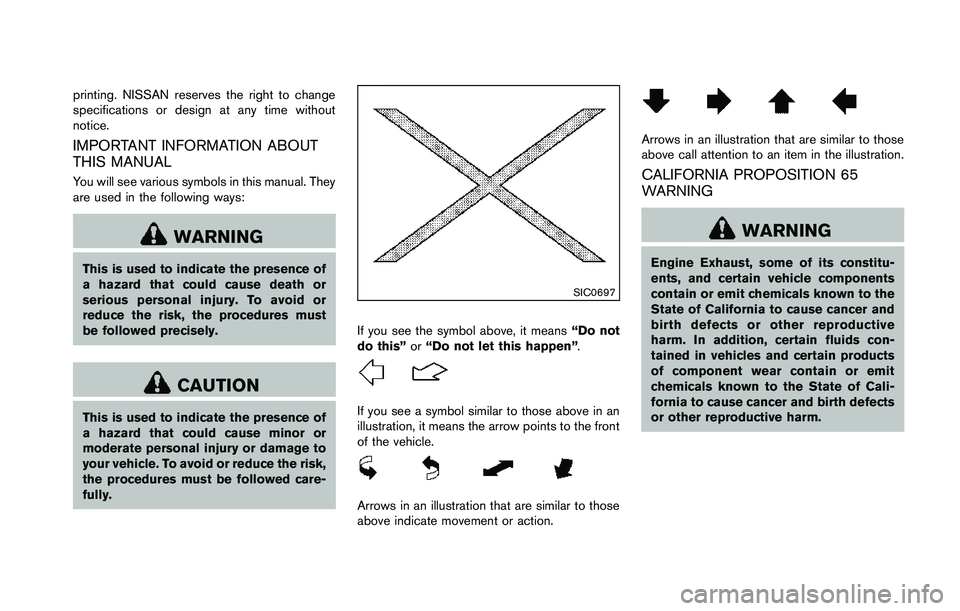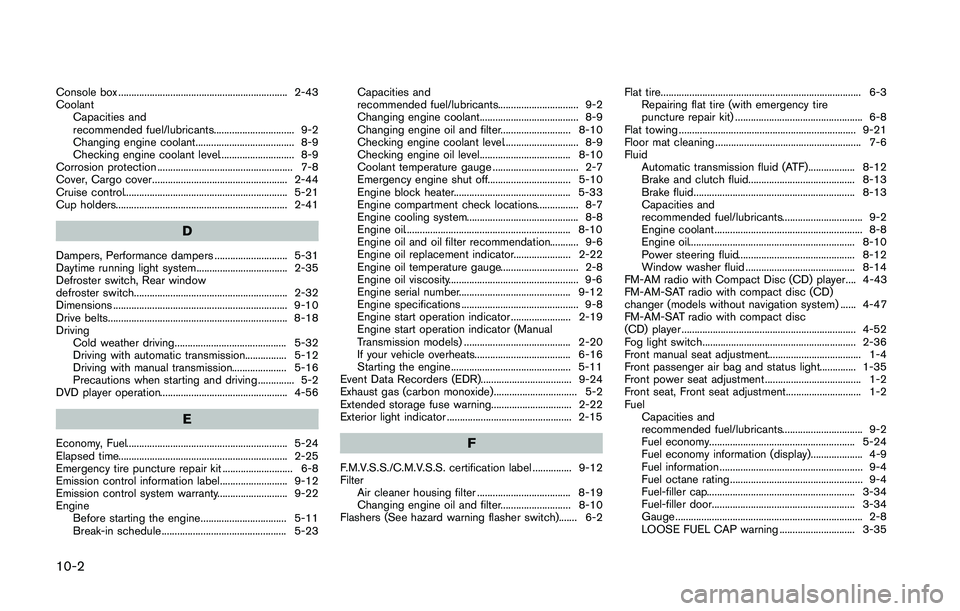2014 NISSAN 370Z change time
[x] Cancel search: change timePage 4 of 428

printing. NISSAN reserves the right to change
specifications or design at any time without
notice.
IMPORTANT INFORMATION ABOUT
THIS MANUAL
You will see various symbols in this manual. They
are used in the following ways:
Page 310 of 428

CAUTION
During the first 1,200 miles (2,000 km) ,
follow these recommendations to ob-
tain maximum engine performance and
ensure the future reliability and econo-
my of your new vehicle.
Failure to follow these recommenda-
tions may result in shortened engine
life and reduced engine performance.
. Avoid driving for long periods at constant
speed, either fast or slow. Do not run the
engine over 4,000 rpm.
. Do not accelerate at full throttle in any gear.
. Avoid quick starts.
. Avoid hard braking as much as possible. Follow these easy-to-use Fuel Efficient Driving
Tips to help you achieve the most fuel economy
from your vehicle.
1. Use smooth accelerator and brake pedal
application.
.Avoid rapid starts and stops..Use smooth, gentle accelerator andbrake application whenever possible.
.Maintain constant speed while commut-
ing and coast whenever possible.
2. Maintain constant speed.
.Look ahead to try and anticipate and minimize stops.
.Synchronizing your speed with traffic
lights allows you to reduce your number
of stops.
.Maintaining a steady speed can minimize red light stops and improve fuel effi-
ciency.
3. Use air conditioning (A/C) at higher vehicle speeds.
.Below 40 MPH (64 km/h), it is moreefficient to open windows to cool the
vehicle due to reduced engine load.
.Above 40 MPH (64 km/h) , it is moreefficient to use A/C to cool the vehicle
due to increased aerodynamic drag.
.Recirculating the cool air in the cabinwhen the A/C is on reduces cooling load.
4. Drive at economical speeds and distances.
.Observing the speed limit and not ex- ceeding 60 MPH (97 km/h) (where
legally allowed) can improve fuel effi-
ciency due to reduced aerodynamic
drag.
.Maintaining a safe following distancebehind other vehicles reduces unneces-
sary braking.
.Safely monitoring traffic to anticipatechanges in speed permits reduced brak-
ing and smooth acceleration changes.
.Select a gear range suitable to road conditions.
5. Use cruise control.
.Using cruise control during highway driving helps maintain a steady speed.
.Cruise control is particularly effective in providing fuel savings when driving on
flat terrains.
6. Plan for the shortest route.
.Utilize a map or navigation system to determine the best route to save time.
7. Avoid idling.
.Shutting off your engine when safe for stops exceeding 30-60 seconds saves
Starting and driving5-23
BREAK-IN SCHEDULE FUEL EFFICIENT DRIVING TIPS
Page 421 of 428

Console box ................................................................. 2-43
CoolantCapacities and
recommended fuel/lubricants............................... 9-2
Changing engine coolant...................................... 8-9
Checking engine coolant level............................. 8-9
Corrosion protection .................................................... 7-8
Cover, Cargo cover.................................................... 2-44
Cruise control............................................................... 5-21
Cup holders.................................................................. 2-41
D
Dampers, Performance dampers ............................ 5-31
Daytime running light system................................... 2-35
Defroster switch, Rear window
defroster switch........................................................... 2-32
Dimensions ................................................................... 9-10
Drive belts..................................................................... 8-18
Driving Cold weather driving........................................... 5-32
Driving with automatic transmission................ 5-12
Driving with manual transmission..................... 5-16
Precautions when starting and driving .............. 5-2
DVD player operation................................................. 4-56
E
Economy, Fuel.............................................................. 5-24
Elapsed time................................................................. 2-25
Emergency tire puncture repair kit ........................... 6-8
Emission control information label.......................... 9-12
Emission control system warranty........................... 9-22
Engine Before starting the engine................................. 5-11
Break-in schedule ................................................ 5-23 Capacities and
recommended fuel/lubricants............................... 9-2
Changing engine coolant...................................... 8-9
Changing engine oil and filter........................... 8-10
Checking engine coolant level............................. 8-9
Checking engine oil level................................... 8-10
Coolant temperature gauge ................................. 2-7
Emergency engine shut off................................ 5-10
Engine block heater............................................. 5-33
Engine compartment check locations................ 8-7
Engine cooling system........................................... 8-8
Engine oil................................................................ 8-10
Engine oil and oil filter recommendation........... 9-6
Engine oil replacement indicator...................... 2-22
Engine oil temperature gauge.............................. 2-8
Engine oil viscosity.................................................. 9-6
Engine serial number........................................... 9-12
Engine specifications ............................................. 9-8
Engine start operation indicator ....................... 2-19
Engine start operation indicator (Manual
Transmission models) ......................................... 2-20
If your vehicle overheats..................................... 6-16
Starting the engine .............................................. 5-11
Event Data Recorders (EDR)................................... 9-24
Exhaust gas (carbon monoxide)................................ 5-2
Extended storage fuse warning............................... 2-22
Exterior light indicator ................................................ 2-15F
F.M.V.S.S./C.M.V.S.S. certification label ............... 9-12
Filter Air cleaner housing filter .................................... 8-19
Changing engine oil and filter........................... 8-10
Flashers (See hazard warning flasher switch)....... 6-2 Flat tire............................................................................. 6-3
Repairing flat tire (with emergency tire
puncture repair kit) ................................................. 6-8
Flat towing .................................................................... 9-21
Floor mat cleaning ........................................................ 7-6
Fluid Automatic transmission fluid (ATF).................. 8-12
Brake and clutch fluid......................................... 8-13
Brake fluid.............................................................. 8-13
Capacities and
recommended fuel/lubricants............................... 9-2
Engine coolant......................................................... 8-8
Engine oil................................................................ 8-10
Power steering fluid............................................. 8-12
Window washer fluid .......................................... 8-14
FM-AM radio with Compact Disc (CD) player.... 4-43
FM-AM-SAT radio with compact disc (CD)
changer (models without navigation system) ...... 4-47
FM-AM-SAT radio with compact disc
(CD) player ................................................................... 4-52
Fog light switch........................................................... 2-36
Front manual seat adjustment.................................... 1-4
Front passenger air bag and status light.............. 1-35
Front power seat adjustment ..................................... 1-2
Front seat, Front seat adjustment............................. 1-2
Fuel
Capacities and
recommended fuel/lubricants............................... 9-2
Fuel economy........................................................ 5-24
Fuel economy information (display).................... 4-9
Fuel information ....................................................... 9-4
Fuel octane rating ................................................... 9-4
Fuel-filler cap......................................................... 3-34
Fuel-filler door....................................................... 3-34
Gauge ........................................................................ 2-8
LOOSE FUEL CAP warning ............................. 3-35